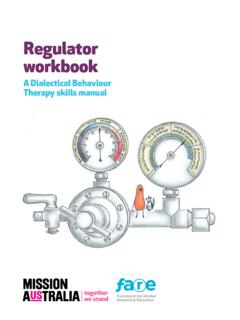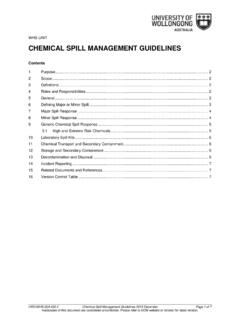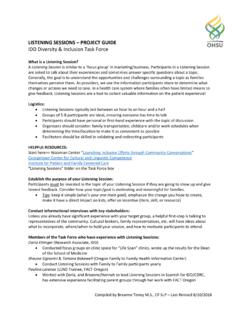Transcription of Palliative Care Outcomes Collaboration Clinical Manual
1 Palliative Care Outcomes Collaboration Clinical Manual Clinical Manual Revised June 2021 2 Table of Contents The Palliative Care Outcomes ..4 ..5 Frequency of ..5 Benefits of Routine Assessment and Outcome ..5 PCOC Strategies, Enablers and ..6 Implementing, Embedding and Sustaining ..7 National Outcome Measures and ..8 Level 1: Patient ..9 Level 2: Episode ..12 Level 3: Phase ..22 Palliative Care .. 27 Resource Utilisation Groups - Activities of Daily Living (RUG-ADL)..30 Australia-modified Karnofsky Performance Status (AKPS)..33 Palliative Care Problem Severity Score (PCPSS)..34 Symptom Assessment Scale (SAS)..34 Embedding Palliative Care ..39 Assessment Process .. 39 List of Figures Figure 1: PCOC Cycle .. 4 Figure 2: Frequency of Assessment .. 5 Figure 3 strategies for successful outcome measurement.
2 6 Figure 4: Implementation Stages .. 7 Figure 5: Patient Outcomes at phase level .. 23 Figure 6: Phase level assessments flow chart .. 29 Version control and change history Version Date Effective Approved by Amendment August 2014 PCOC Director Not applicable for first version April 2018 Sabina Clapham Revised forms, changing the order of assessment tools SAS first and phase last. June 2021 Dr Barbara Daveson Revised implementation steps and SAS instructions for patients to match implementation guide and talking about your symptoms guide for patients and families. PCOC is a national Palliative care project funded by the Australian Government Department of Health. Clinical Manual Revised June 2021 3 Prepared by Clapham S and Holloway A for the Palliative Care Outcomes Collaboration (2014) Australian Health Services Research Institute (AHSRI), University of Wollongong, NSW 2522 Australia.
3 PCOC 2014. PCOC is an outcome and benchmarking program. PCOC creates a Clinical language by embedding five validated Clinical assessments to systematically measure and improve patient and family/carer Outcomes . For more information visit the PCOC website. PCOC UOW 2019. The intellectual property associated with the Clinical Manual is owned by the Palliative Care Outcomes Collaboration (PCOC), University of Wollongong. PCOC has placed this resource in the public domain and it can be used without charge. The PCOC suite of resources, including this resource, cannot be modified or developed without the consent of the University Manager, Palliative Care Outcomes Collaboration (PCOC). Requests and enquiries concerning reproduction and rights should be addressed to: Director, Palliative Care Outcomes Collaboration (PCOC) Australian Health Services Research Institute (AHSRI) Building 234 (iC Enterprise 1) Innovation Campus University of Wollongong NSW 2522 The complete list of PCOC publications are available from: Clinical Manual Revised June 2021 4 Ongoing Point-of-care assessmentsRoutinereportingBenchmarkingS tructured report feedback Every six monthsFigure 1: PCOC Cycle Figure 1: PCOC Cycle The Palliative Care Outcomes Collaboration Central to the PCOC program is a framework and protocol for routine Clinical assessment and response.
4 By embedding the framework into routine Clinical practice, a common Clinical language is created. This helps identify and respond to needs. It also helps with improving access to Palliative care, and generating consistent information to plan and deliver care. The PCOC cycle centres on measuring patient and carer Outcomes , benchmarking these Outcomes nationally, and using them to identify processes that can be improved. refer to Figure 1 [1]. PCOC provides support and resources to enable clinicians and organisations to implement the PCOC assessment and response framework out outcome measures and facilitate continuous improvement. Quality improvement is enabled through our network of Improvement Facilitators, our community of practice, and our quality improvement resources. Clinical Manual Revised June 2021 5 Figure 2: Frequency of Assessment Introduction This Manual is designed for Palliative care clinicians to understand and utilise the PCOC assessment tools and data items as part of routine Clinical practice.
5 The Manual includes: Assessment tool definitions Data item definitions Forms Information on the benchmarks and outcome measures. Additional educational resources found at Frequency of Assessment PCOC provides clinicians with tools to systematically assess individual patient experiences using validated Clinical assessment tools. It is helpful to view assessments as Palliative care observations or vital signs. Assessments can be conducted in-person or via the telephone. The frequency of assessment is outlined in the figure. Assessments are conducted daily or at contact to detect changes in patient and family/carer needs. Benefits of Routine Assessment and Outcome Measurement Standard assessment and communication Baseline assessment and snapshot of patient needs Track and respond to symptom and problems Patient, family and carers are part of decision making and care is driven by need The Palliative care service measures and improves the care it provides Better patient experience & Improved Outcomes of care Clinical Manual Revised June 2021 6 Strategies for successful outcome measurement Strategy Enablers PCOC Support Figure 3 strategies for successful outcome measurement For further information, refer to the PCOC Implementing PCOC.
6 A guide for services Leadership and GovernanceParticipate in report feedback and benchmarking sessions , designate champions, develop local protocols, policies & guidelines. Provide patient outcome report support. Hold benchmarking Clinical AssessmentEmbed assessments into routine practice, support staff to attend resources, documentation, support, strategies and Entry, Extraction & QualityCollect entire data set, submit on time, identify person/s responsible for data entry, correcting errors & identify cause of such data entry practices, support entry person/s, undertake quality checks, assist in identifying causes of & EducationEnsure staff are orientated, support and ensure staff attend PCOC workshops and workshops, on-site education, and self-directed education resources on PCOC , change & ResearchOutcome reports, benchmarks and supplementary data are used for regular audit and case review and to identify potential improvement and research and facilitate research opportunities using PCOC longitudinal database.
7 Clinical Manual Revised June 2021 7 Implementing, Embedding and Sustaining PCOC For further information, refer to the Implementing PCOC: a guide for services There are five distinct stages in implementing the PCOC program into routine practice at a service and There are three distinct stages in starting PCOC and establishing it as routine practice at a service and organisational level; these are planning, implementing and reviewing. The development of an implementation plan is supported by completion of the readiness assessment. 1. PLAN 2. IMPLEMENT 3. REVIEW Ensure organisation and service 'readiness' Establish governance Re-engineer processes to incorporate assessment and response protocol Incorporate PCOC into orientation and training and data collection systems Commence routine patient assessment using PCOC's assessment and response protocol Commence data entry Submit first 6 month patient data for PCOC report First PCOC report Undertake audit and case review Incorporate PCOC in routine quality improvement and accreditation activities PCOC information used for service planning and research 1-6 months +6 months + 6-18 months Figure 4: Implementation Stages Role of the PCOC Clinical Lead A factor critical to the successful implementation of the PCOC program is the designation of a PCOC Clinical lead (champion).
8 This role includes: Act as a role model to support and re-inforce the assessment and response processes Provide staff with information and orientation to the PCOC resources Guide and support staff to complete the Essentials Online course and orientation to PCOC Work with the PCOC Improvement Facilitator to support local process for embedding and sustaining PCOC Provide feedback to the leadership team on any identified areas for improvement. Clinical Manual Revised June 2021 8 National Outcome Measures and Benchmarks The objective of PCOC is to drive systematic improvement in patient Outcomes through benchmarking. Benchmarking was introduced in 2009 and since then participating Palliative care services have achieved statistically significant improvement in all outcome measures. Outcome measures capture the Clinical concepts: Timeliness of Palliative care Responsiveness to urgent needs Anticipatory care Responsive care Change in symptoms adjusted by phase and symptom score Timeliness of Palliative care Time from date ready for care to episode start.
9 90% of patients have their Palliative care commence within two days when ready for care. Responsiveness to urgent needs Time in the unstable phase. 90% of patients in the unstable phase have their needs met addressed within 3 days or less. Anticipatory Care 90% of patients with absent or mild symptoms/problems at the beginning of the phase have absent or mild symptoms/problems at the end of the phase. For Pain (SAS), Pain (PCPSS), Fatigue, Breathing problems and Family/Carer Problems Responsive Care 60% of patients with moderate or severe symptoms/problems at the beginning of the phase have absent or mild symptoms/problems at the end of the phase. For Pain (SAS), Pain (PCPSS), Fatigue, breathing problems and Family/Carer Problems Change in symptoms relative to the national average (casemix adjusted) The change in symptoms relative to the national average measures the mean change in symptoms and is adjusted for both phase and for the symptom score at the start of each phase.
10 This measure allows comparison of change in symptom score for like patients. A positive score indicates that a service is performing above the baseline national average and a negative score that it is below the baseline national average. For Pain (SAS), Pain (PCPSS), Breathing problems, Nausea, Bowel problems, other symptoms, Psychological/Spiritual and Family/Carer Problems For further information, refer to the National Outcome Measures and Benchmarks page on the PCOC website, or refer to the Development of Benchmarks page. Clinical Manual Revised June 2021 9 Level 1: Patient Information Patient level information describes demographics. Refer to example of episode form on page 18. PCOC defines a patient as a person for whom a Palliative care services accepts responsibility for assessment and/or treatment as evidenced by the existence of a medical record.












